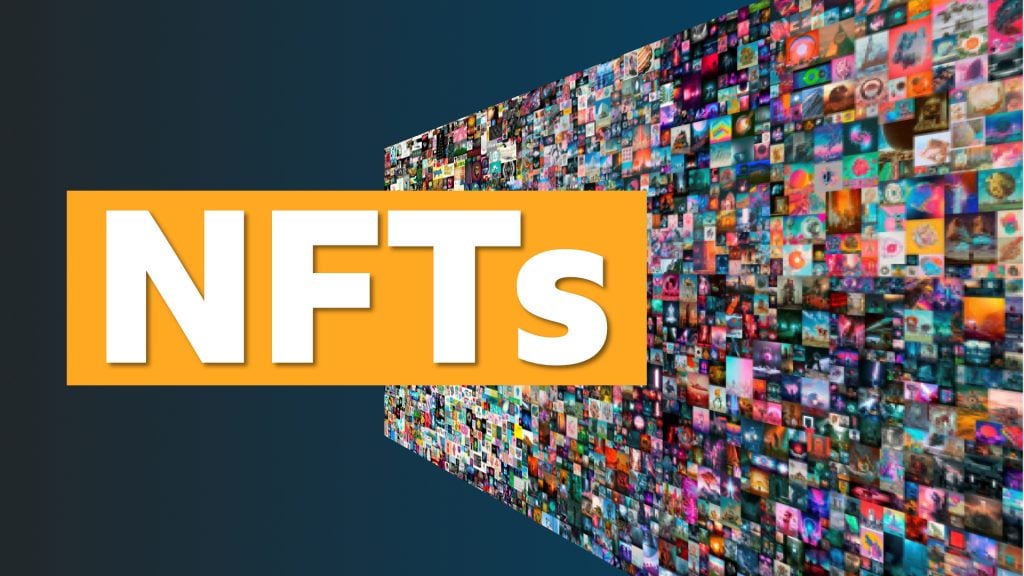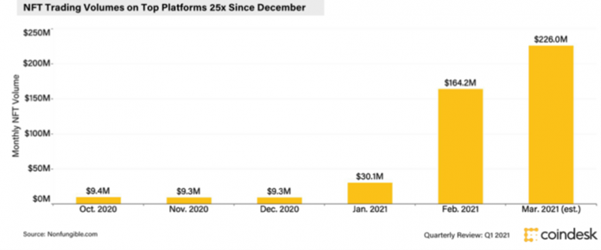
This article was submitted by a Guest Contributor. The opinions expressed in this publication are those of the Guest Contributor.
Sometime around March, you probably read several explainer articles with titles along the lines of, “What are NFTs?” and “NFTs, explained”.
That was the month non-fungible tokens (NFTs) were thrust into the public consciousness. British auction house Christie’s sold an NFT artwork by digital artist Mike Winkelmann, better known as Beeple, for a historic US$69 million. Later, Twitter CEO Jack Dorsey sold an NFT of first tweet for US$2.9 million.
The numbers paint a better story – the volume of NFT transactions multiplied 25 times since December 2020, totalling around US$226 million.

The NFT market has somewhat cooled off since the frenzy, following the broader crypto pullback in the past month. In the long-term, a correction is probably beneficial to skim off the froth in the NFT market.
It also gives us a chance to step back, look past all the hype and take a deeper look at NFTs. This article aims to give you a high-level overview of NFTs, why they are interesting, and introduce some of its popular use cases.
Why NFTs are interesting
NFTs are an application of blockchain technology. And fundamentally, blockchains track proof of ownership, backed by an immutable ledger. NFTs extend that idea beyond cryptocurrency to include digital assets. These assets include items such as digital art, domain names, collectible sports cards, virtual real estate.
NFTs, coupled with the financial aspects of cryptocurrencies, allow people to issue, own, and trade digital assets within one platform. Previously siloed digital assets, like art and tradable in-game items, now have a shared platform. Think Carousell, but for digital items.
NFT basics
To understand non-fungible tokens, let’s breakdown the term, starting with “T”.
A token seems like a straightforward concept at first. But don’t confuse it with cryptocurrencies. There is a difference. Cryptocurrencies are a native asset of a blockchain, like bitcoin or ether. Tokens are built on top of existing blockchains. Today, most NFTs are built on Ethereum.
Fungibility is an economic concept. It describes a good that is replaceable by another identical item. Currency is the standard example. Bitcoin or dollars are fungible because 1 BTC / $1 USD is exchangeable for another 1 BTC / $1 USD.
Hence, non-fungible refers to a unique asset. NFTs are distinct from cryptocurrencies because they cannot be directly exchanged with one another.
How do NFTs work?
Next, we have to understand a little bit about blockchain technology because it underpins how NFTs work. There are two key properties it provides: uniqueness and proof of ownership. In both, public-key cryptography is a core piece.
Public-key cryptography is an encryption technique that uses a paired public and private key algorithm. On the internet, it ensures your messages are only seen by the intended recipient.
If a friend wanted to send you a message, they would use your public key to scramble their message into an unintelligible sequence of random characters. If bad actors intercept the message, it would look like gibberish to them. But with your private key it can be returned to its original form.
The same mathematical properties that keep your messages private is used by the blockchain to securely store a growing list of records. Each block is locked by a cryptographically signed transaction.
Every new block is also cryptographically linked to the previous block. As more blocks are added, altering transaction data becomes even more difficult. Because it’s infeasible for records to be modified, any buyer of NFTs can be assured of a token’s authenticity.
Next, when you buy an NFT, you get the right to transfer the token to your digital wallet. The content creator’s public crypto key certifies that you’re buying an authentic product. Your private crypto key is the proof of ownership of the original. This pair of the creator’s public key and the owner’s private key proves that your copy of a digital file is the original.
NFTs and digital content
To help contextualise what this means, let’s go back to the Beeple example. Digital art was one of the earliest use-cases for NFTs. It makes sense when you realise what makes physical art valuable is the ability to reliably prove the ownership of a piece and display it somewhere.
For example, you could easily take a picture of the Mona Lisa. Or print a high-resolution version and frame it in your living room. But there will only be one original, displayed in the Louvre.
NFTs ensure verifiable scarcity and ownership. In other words, they bring the elements that endow physical assets with value into the digital world.
You can easily lookup Beeple’s piece, “Everydays: the First 5,000 Days” online. You could save it and have a perfect replica of the artwork. But only one person – presently Vignesh Sundaresan, aka MetaKovan, will own the NFT.
The Beeple sale was a landmark because it proved that digital art is just as valuable as our conventional definitions of art. It could open up a path for all kinds of digital content creators to get paid for their work.
Prior to the Christie’s auction, Beeple had previously not sold a print for more than $100. Then, he was already a well-known artist with 1.8 million followers on Instagram. He also collaborated with brands like Nike, and artists such as Katy Perry. Even with his stature, he couldn’t make money from his personal art.
Of course, 99.99% of artists are not going to see a $69 million paycheck. But it could potentially allow content creators to monetise their art. And they don’t need to rely exclusively on platforms sharing their slice of the ad revenue to do it.
As NFTs are programmable, creators can ensure they’re getting their fair share. One function currently used are automatic commissions. NFTs can be hardcoded to automatically pay out royalties to the creators when they’re sold.
Other notable NFT projects
Digital art was one of the earliest use cases, but the NFT universe is constantly expanding. At the moment, here are the more successful NFT projects.
NBA Top Shots is a platform that basketball fans to collect and sell officially-licensed video highlights. For instance, this NFT of Lebron James dunking was recently sold for US$210,000. NBA trading cards were already a popular physical collectible. Top shots may have been popular because it’s so easy to grasp the idea of a digital collectible.
Cryptopunks is a project by Larva Labs. It features 10,000 unique collectible ‘characters’ on Ethereum. Most are human, but there are human but some are zombies, apes. The most rare breed are nine aliens. One of these aliens sold in March for 4,200 ETH, about US$7.5 million.
OpenSea, launched in 2017, is a one-stop shop to discover, buy and sell NFTs. It’s backed by well-known investors including venture capital firm Andreesen Horowitz. On their blog, they write that OpenSea “provides the link between the consumer layer and the infrastructure layer for the digital goods economy and is a key utility in this new world of digital ownership.”
Apart from digital content, another interesting project is the Ethereum Name Services (ENS). It’s a domain naming platform, essentially a decentralised version of GoDaddy.com. The domain names are represented as an NFT, allowing the owner to receive any cryptocurrency and launch a decentralised website. To date there are more than 238,000 domain names registered on the platform with more than 71,000 owners.
Conclusion
NFTs are exciting because they eliminate the “cost of trust” – the middlemen between buyer and seller that verifies authenticity and establishes trust in the transaction.
Transactions recorded on blockchains are reliable because the information cannot be easily modified. Smart contracts reduce the reliance on intermediaries because they can automatically release assets when both parties honour their agreements. Tokenising various digital assets provides a standardised form for moving around a system.
However, it is important to note that NFTs – and blockchain technology as a whole – are a new and unproven technology. As we will see, a lot of the technical, legal and social infrastructure surrounding the technology is still significantly underdeveloped.
This leads us to the big question: are NFTs a bubble, or are they here to stay? This is a meaty topic that’s worth unpacking in detail, so we’ll save that discussion for Part II of this article. Stay tuned!
[mc4wp_form id=”173″]
This article was submitted by a Guest Contributor. The opinions expressed in this publication are those of the Guest Contributor.
I think it is better to do US stock, SGX stock suck really, Lucky in may last year i go wall st, today i am still up a whopping 2.5X. Most of my friend at SGX are still inside the toilet.